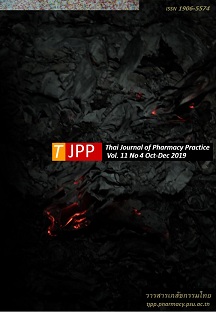ผลของการบริบาลทางเภสัชกรรมต่อคุณภาพชีวิตของผู้ป่วยโรคมะเร็งเต้านม: การทดลองแบบสุ่มและมีกลุ่มควบคุม
Main Article Content
บทคัดย่อ
วัตถุประสงค์: เพื่อศึกษาผลของการบริบาลทางเภสัชกรรมต่อคุณภาพชีวิตและการเกิดอาการไม่พึงประสงค์ของผู้ป่วยโรคมะเร็งเต้านมที่ได้รับยาเคมีบำบัด วิธีการ: การศึกษานี้เป็นการทดลองแบบสุ่มและมีกลุ่มควบคุมแบบคู่ขนานในผู้ป่วยโรคมะเร็งเต้านมรายใหม่ที่ได้รับการรักษาด้วยยาเคมีบำบัด ณ โรงพยาบาลกำแพงเพชร การศึกษาเปรียบเทียบระหว่างกลุ่มที่ได้รับการบริบาลทางเภสัชกรรมก่อนพบแพทย์โดยมีเภสัชกรค้นหาและแก้ไขปัญหาจากการใช้ยา กับกลุ่มที่ได้รับการดูแลตามมาตรฐานปกติของโรงพยาบาล การศึกษาสุ่มตัวอย่างเข้ากลุ่มโดยใช้วิธีการสุ่มแบบกลุ่มย่อยด้วยบัญชีสุ่มตัวอย่าง ผลลัพธ์หลักคือคุณภาพชีวิตโดยวัดด้วย Functional Assessment of Cancer Therapy-Breast (FACT-B) ฉบับภาษาไทย ผลลัพธ์รอง คือ อาการไม่พึงประสงค์โดยใช้เกณฑ์ Common Terminology Criteria for Adverse Events เวอร์ชั่น 4.0 (CTCAE) การศึกษาติดตามผู้ป่วยจนถึงการรักษาด้วยยาเคมีบำบัดรอบที่ 3 ผลการวิจัย: มีผู้เข้าร่วมการศึกษารวม 54 คน อายุเฉลี่ย 53.3 ปี โดยเป็นผู้ที่ได้รับการบริบาลทางเภสัชกรรมก่อนพบแพทย์ 27 คน และผู้ที่ได้รับการดูแลตามมาตรฐานปกติ 27 คน หลังได้รับยาเคมีบำบัดรอบที่ 3 พบว่า ค่าเฉลี่ย+ส่วนเบี่ยงเบนมาตรฐานของคุณภาพชีวิตโดยรวมของผู้ป่วยที่ได้รับการบริบาลทางเภสัชกรรมก่อนพบแพทย์สูงกว่าผู้ป่วยที่ได้รับการดูแลตามมาตรฐานปกติ (132.8+7.6 เทียบกับ 119.2+14.3, P<0.001) นอกจากนี้ยังพบว่า ผู้ป่วยที่ได้รับการบริบาลทางเภสัชกรรมก่อนพบแพทย์เกิดอาการคลื่นไส้และเบื่ออาหารน้อยกว่าผู้ป่วยที่ได้รับการดูแลตามมาตรฐานปกติ (ร้อยละ 0.0 เทียบกับร้อยละ 29.6, P=0.004 และร้อยละ 7.4 เทียบกับร้อยละ 37.0, P=0.009 ตามลำดับ) สรุป: การให้บริบาลทางเภสัชกรรมก่อนพบแพทย์สามารถเพิ่มคุณภาพชีวิต และลดการเกิดอาการไม่พึงประสงค์จากยาเคมีบำบัดของผู้ป่วยได้ จึงควรสนับสนุนการให้บริการดังกล่าวแก่ผู้ป่วยโรคมะเร็งเต้านมที่ได้รับยาเคมีบำบัด
Article Details
ผลการวิจัยและความคิดเห็นที่ปรากฏในบทความถือเป็นความคิดเห็นและอยู่ในความรับผิดชอบของผู้นิพนธ์ มิใช่ความเห็นหรือความรับผิดชอบของกองบรรณาธิการ หรือคณะเภสัชศาสตร์ มหาวิทยาลัยสงขลานครินทร์ ทั้งนี้ไม่รวมความผิดพลาดอันเกิดจากการพิมพ์ บทความที่ได้รับการเผยแพร่โดยวารสารเภสัชกรรมไทยถือเป็นสิทธิ์ของวารสารฯ
เอกสารอ้างอิง
2. Ministry of Public Health. Health data center 2018 [online]. 2018 [cited Oct 27, 2018]. Available from: hdcservice.moph.go.th/hdc/reports/report.php?source=formated/ncd.php&cat_id=59acae7a68f02c8e2c0cb88dfc6df3b3&id=825c7fbfdbde936cf821a9b16dc4189b.
3. Strategy and Planning Division. Public health statistics A.D.2016 [online]. 2018 [cited Feb 25, 2018]. Available from: bps.moph.go.th/new_bps/site s/default /files/health_strategy2559.pdf.
4. Sookprasert A. A step by step practical guide before giving chemotherapy [online]. 2011 [cited Feb 25, 2018]. Available from: thaihp.org/index2.php?option =showfile&tbl=home&id=972.
5. Bastani P, Ahmad Kiadaliri A. Health-related quality of life after chemotherapy cycle in breast cancer in Iran. Med Oncol. 2011; 28 Suppl 1:S70-4.
6. Park H, Yoon HG. Menopausal symptoms, sexual function, depression, and quality of life in Korean patients with breast cancer receiving chemotherapy. Support Care Cancer. 2013; 21: 2499-507.
7. Montakantikul P. Systematic pharmaceutical care. In: Ningsanon T editor. Essential tools for pharma ceutical care. Bangkok: Prachachon; 2015. p. 9-32.
8. Subongkot S, Srisawat S, Pratheepawanit Johns N, Sookprasert A. Outcome of chemotherapy counse- ling in oncology patients by pharmacist. Isan Journal of Pharmaceutical Sciences. 2019; 5: 34-45.
9. Chuepool Y. Effects of pharmaceutical care on quality of life in lung cancer patients treated with chemo- therapy at Maharaj Nakorn Chiang Mai Hospital, Chiang Mai Province [master thesis]. Chiang Mai: Chiang Mai University; 2005.
10. Liekweg A, Westfeld M, Braun M, Zivanovic O, Schink T, Kuhn W, et al. Pharmaceutical care for patients with breast and ovarian cancer. Support Care Cancer. 2012; 20: 2669-77.
11. Kawaguchi T, Iwase S, Koinuma M, Onodera Y, Takeuchi H, Umeda M, et al. Determinants affecting quality of life: implications for pharmacist counseling for patients with breast cancer in Japan. Biol Pharm Bull. 2012; 35: 59-64.
12. Cushnie B, Hatsarin S. Effect of pharmaceutical care among breast cancer patients undergoing chemotherapy at Udonthani Regional Center, Thailand. Thai Cancer Journal 2011; 31: 93-105.
13. Oken MM, Creech RH, Tormey DC, Horton J, Davis TE, McFadden ET, et al. Toxicity and response criteria of the Eastern Cooperative Oncology Group. Am J Clin Oncol 1982;5:649-655.
14. Eng J. Sample size estimation: how many indivi- duals should be studied? Radiology. 2003; 227: 309-13.
15. Collins KMT, Onwuegbuzie AJ, Jiao QG. A mixed methods investigation of mixed methods sampling designs in social and health science research. J Mix Methods Res 2007; 1: 267-94.
16. Kaewkungawal J, Singhasivanon P. Sample size in clinical research. In: Pitisuttithum P, editor. Textbook of clinical research. Bangkok: Amarin Printing; 2014. p.134-5.
17. Brady MJ, Cella DF, Mo F, Bonomi AE, Tulsky DS, Lloyd SR, et al. Reliability and validity of the Functional Assessment of Cancer Therapy-Breast quality-of-life instrument. J Clin Oncol 1997; 15: 974-86.
18. Sirilerttrakul S, Jirajarus M, Ratanatharathon V, Nuch Charoenkul, Sirachainan E, Nilchaikovit T. Quality of life measurement of Functional Assess ment of Cancer Therapy (FACT) translated into Thai In breast cancer, colon cancer and lung cancer patients. Thai Journal of Nursing Research. 2000; 4: 61-76.
19. Ratanatharathorn V, Sirilerttrakul S, Jirajarus M, Silpakit C, Maneechavakajorn J, Sailamai P, et al. Quality of life, Functional Assessment of Cancer Therapy-General. J Med Assoc Thai 2001; 84: 1430- 42.
20. National Cancer Institute. Common Terminology Criteria for Adverse Events (CTCAE) Version 4.0 [on line]. 2009 [cited Mar 3, 2015]; Available from: evs.nc I.nih.gov/ftp1/CTCAE/CTCAE_4.03_2010-06-14_Qu ickReference_8.5x 11.pdf.
21. Pratheepawanit NJ. Introduction. In: Pratheepawanit NJ. Health-related quality of life: evaluation and appli cation. Khon Kaen: Khon Kaen University printing; 2009. p. 9-12.
22. Cella DF. Quality of life: concepts and definition. J Pain Symptom Manage. 1994; 9: 186-92.
23. Petpichetchian W. Best nursing practice in cancer care. Songkhla: Orang media; 2011.
24. Jewpattanakul Y, Phuphaibul R, Loveland-Cherry C, Nityasuddhi D, Suwonnaroop N. Factors influencing well-being among families with adolescents living in and around Bangkok, Thailand. Pacific Rim Interna tional Journal of Nursing Research. 2010; 14: 235-248.
25. Pratheepawanit JN, Weerapreeyakul T, Vashirodom D, Putthisavat V, Wiangnon S, Limwattannanom C. Evaluation of the impact of treatments on quality of life of breast cancer patients and quality of life database in Khon Kaen province [research report]. Khon Kaen: Khonkaen University; 2009.
26. Jaeschke R, Singer J, Guyatt GH. Measurement of health status. Ascertaining the minimal clinically im portant difference. Control Clin Trials 1989; 10: 407-15.
27. Cheung YT, Foo YL, Shwe M, Tan YP, Fan G, Yong WS, et al. Minimal clinically important difference (MC ID) for the functional assessment of cancer therapy: Cognitive function (FACT-Cog) in breast cancer patients. J Clin Epidemiol 2014; 67: 811-20.
28. Ob-oun T, Kopol J, Phosahut P, Thirasirawate S, Chisong C, Phumart P, et al. Adverse drug reaction monitoring and counseling in oncologic patients at Mahasarakham Hospital Khon Kaen [online]. 2012 [cited Dec 11, 2017]. Available from: pharm.kku.ac.th /isan-journal/journal/volumn8-no1/4annual/017-MSU _Pages_135-143.pdf.


